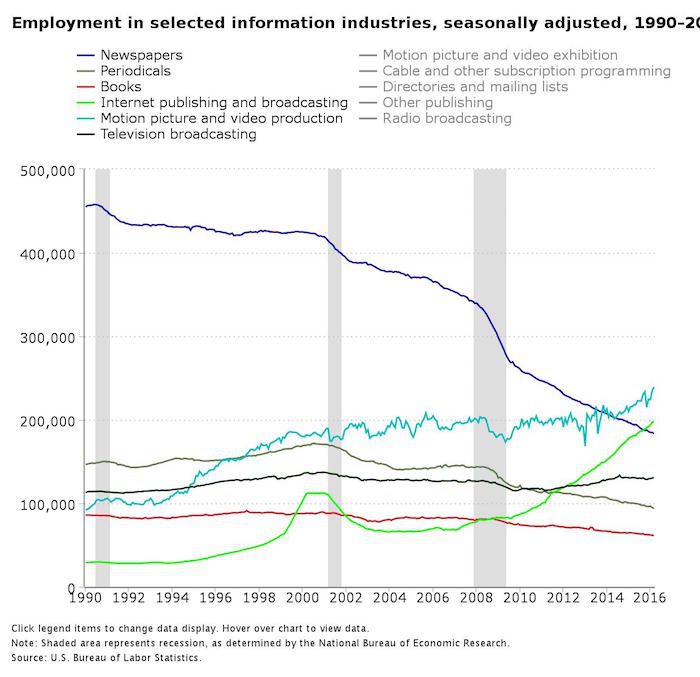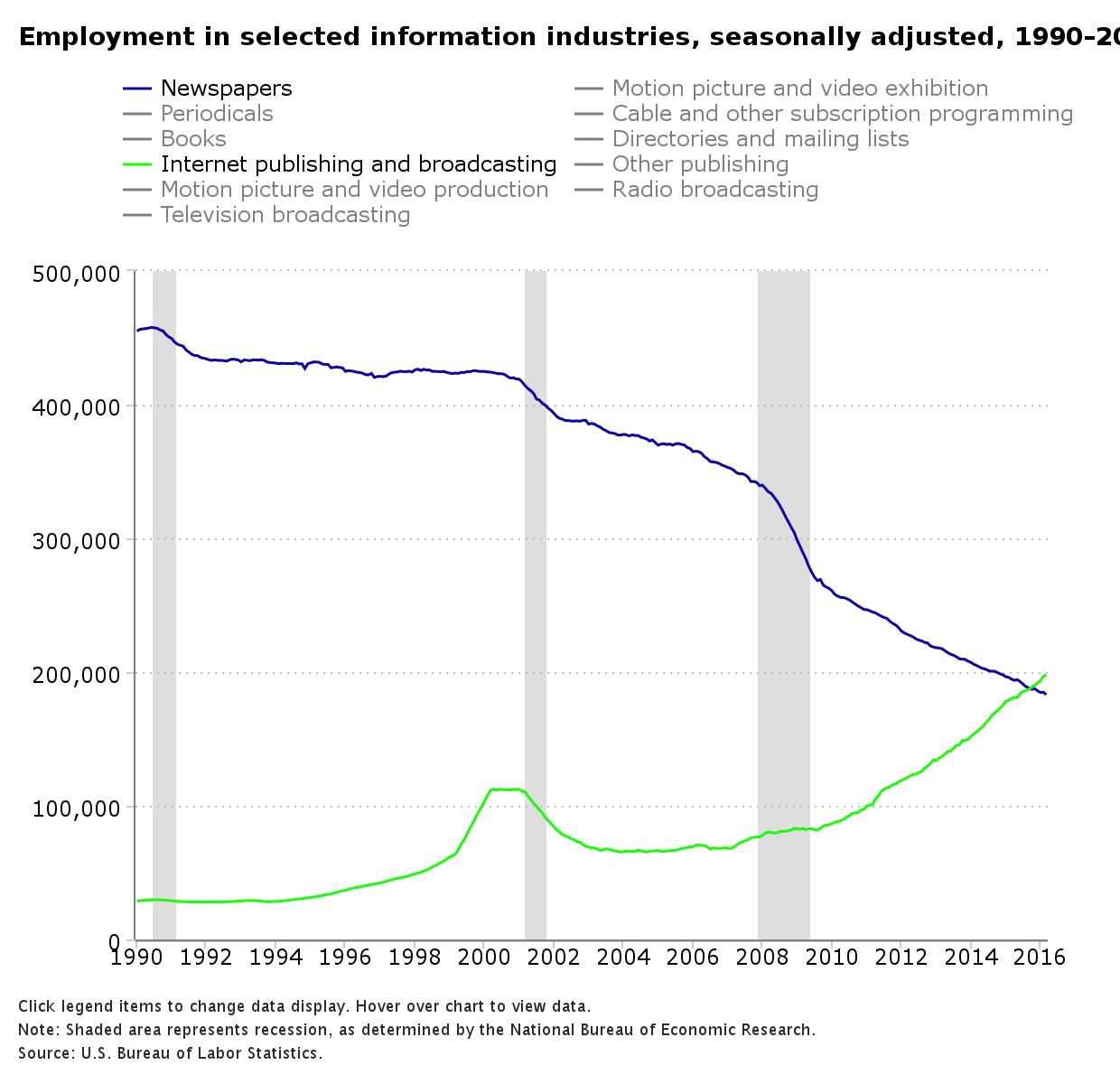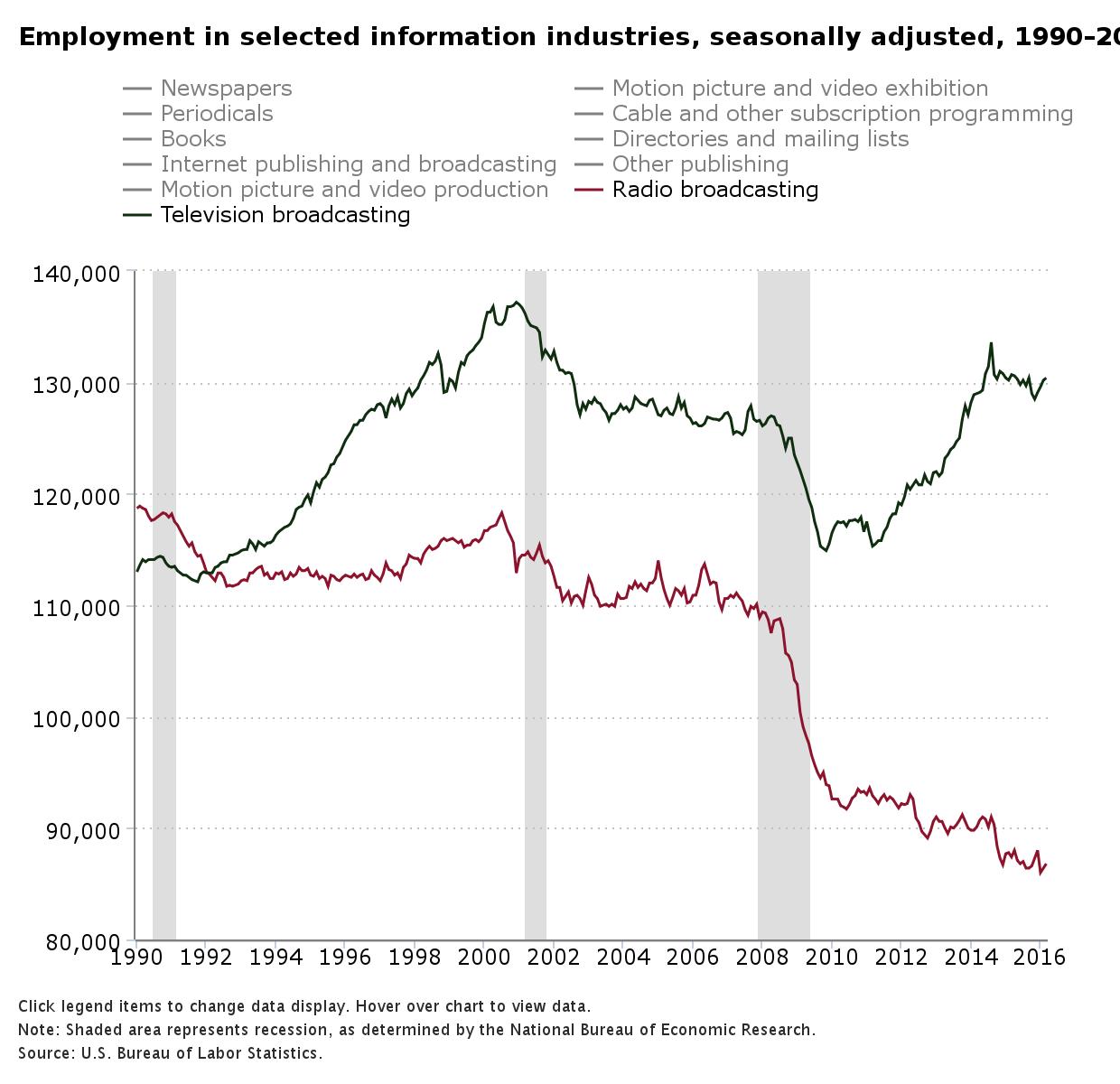
There are now more Americans working for online publishers and broadcasters than for newspapers, according to data from the U.S. Bureau of Labor Statistics. Employment at online outlets first eclipsed newspapers in October 2015.

As of March, there were 197,800 Americans working in the “internet publishing and broadcasting” sector versus 183,200 people working for U.S. newspapers. (To be fair, “Internet publishing and broadcasting” includes a variety of jobs not particularly comparable to newspaper jobs. It’s the trend lines that are important here.)
The BLS data goes back to 1990, and since then employment at newspapers has fallen by nearly 60 percent, having peaked in June 1990 at 457,800 people. The number of newspaper jobs has fallen consistently since then.
Digital publishing, meanwhile, has grown considerably. Throughout much of the early 1990s there were around 30,000 online publishing jobs, though that figure grew to 112,000 by 2000. Then the dot-com bubble burst and the number of jobs shrunk by about half.
Online-only publishing jobs picked up again in the late aughts, and continued to grow during the aftermath of the 2008 financial crisis. The number of jobs has more than doubled since then.
It’s safe to assume that newspaper jobs will continue to evaporate. Most small and mid-sized metro papers are struggling to find new revenue as print advertising and circulation decline and online advertising fails to make up the difference.
Even large national newspapers, such as The New York Times, are still figuring out to adapt as the internet age. The Times has more than 1 million digital-only subscribers, and it has goals to reach $800 million in digital revenue by 2020, but Vanity Fair reported that the Times is planning at least 200 newsroom layoffs early next year.Many are also questioning the sustainability of online-only business models as well. The Financial Times reported this spring that BuzzFeed cut its 2016 revenue projections in half after it missed its 2015 goals (BuzzFeed disputes the specific totals). Mashable cut 30 jobs in April and has dealt with an exodus of a number of other journalists after it decided to shift its focus toward video.
While newspaper job losses have been the steepest, other sectors have also seen decreases in job numbers. Employment at periodicals fell 37 percent from a peak of 150,100 in December 1990 to 93,600 in March.
Radio broadcasting jobs fell from January 1990 to March by about 27 percent. As of March, there were 130,400 Americans working in television broadcasting.

The full data set is available here.
5 comments:
I think this article would be stronger with a better discussion of what’s included in this labor category. I clicked the link included in the article and it already seems broad (game sites and software publishing). But Netflix seems pretty close to “Internet broadcasting,” and Youtube does as well. What about Facebook? Those curators that caused such a stir recently seem like they’re doing something like “Internet publishing”…
Or maybe not, of course. There’s no doubt that newspaper employment is falling like a rock; I just would like to know if the jobs that newspapers are being compared to here are involved in the production of what we think of as “news.”
Ditto UptownMessenger’s comment. The “online-only outlets” reference in the headline for this piece makes what appears to be an unfounded leap, based on the admittedly limited detail the Department of Labor provides about the category of “internet publishing and broadcasting.”
Worse — not your fault but it should be noted — the internet category used in these stats was discontinued in a 2007 rewrite of the NACIS (North American Industry Classification System) by the Bureau of Labor Statistics. After 2007, it indicates that what used to be internet publishing and broadcasting is now grouped in an “other information services” (see http://www.bls.gov/iag/tgs/iag519.htm) category that includes, among other things, libraries. Not terribly helpful for our purposes.
It raises several questions about how the BLS put together the chart that was the peg for this posting.
Doesn’t seem like the charts are working… Are they just screenshots? None of the interactive functionality is there
I like this website very much, Its a very nice situation to read and obtain information. “What is called genius is the abundance of life and health.” by Henry David Thoreau.
Howdy! I could have sworn I’ve been to this web site before but after going through many of the articles I realized it’s new to me. Regardless, I’m definitely happy I stumbled upon it and I’ll be book-marking it and checking back regularly!
Trackbacks:
Leave a comment